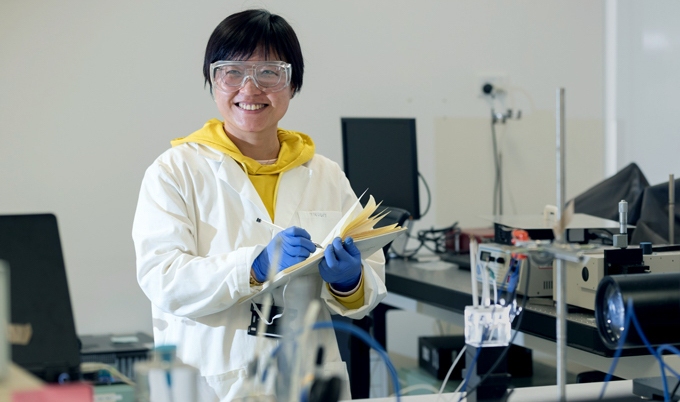Researchers at the College of Engineering, Computing & Cybernetics (CECC) have enlisted artificial intelligence (AI) to conduct simulated experiments that optimise the catalytic reaction that generates green hydrogen.
 “By harnessing the power of ML, we can analyse vast datasets and predict the behaviour of different material combinations, effectively speeding up the material development process,” said Dr Siva Karuturi, an Associate Professor in the School of Engineering.
“By harnessing the power of ML, we can analyse vast datasets and predict the behaviour of different material combinations, effectively speeding up the material development process,” said Dr Siva Karuturi, an Associate Professor in the School of Engineering.
Green hydrogen is a clean-burning, zero-carbon fuel carrier embraced as a vital component of Australia renewable energy transition. It is produced by splitting water into hydrogen and oxygen using energy from sunlight or wind.
One of the cost barriers involves the catalytic materials that facilitate the (photo)electrochemical process. Currently, the most effective catalysts are made of rare metals that are costly to obtain.
The new research deploys machine learning (ML) simulations to identify the most effective fabrication and chemical makeup of a new generation of catalysts. The resulting chemical species are then engineered and verified with traditional laboratory methods.
“A single simulated dataset based on preliminary experiment results can give you a prediction for thousands of possible structures,” said Dr Doudou Zhang a chemist and engineer at the Australian National University (ANU) specialising in solar-driven electrochemical energy conversion.
Dr Zhang served as lead investigator on the study.
“The optimisation process guided by ML is accurate and comprehensive, and it saves time and resources spent on blind and broad trials in the labs to explore the catalysts one-by-one,” she said.
The research, which paves the way for data-driven computational experiments to discover other functional catalysts in the renewable energy field, was supervised by Dr Karuturi and Dr Kylie Catchpole and published last month in the Royal Society of Chemistry’s prestigious journal, Energy & Environmental Science.
Chemical reaction seeds energy transition
Green hydrogen production is a topic of national and international interest.
The Australian government announced on 10 October a $2 billion Hydrogen Headstart program as part of its National Hydrogen Roadmap, which proclaims Green hydrogen a “significant opportunity for growth and a key enabler of the energy transition”.
 Green hydrogen can replace fossil fuels in heavy industries such as steel production and mining. ANU experts foresee it becoming an economic boon for Australia as well, as green hydrogen is produced here and exported to countries where solar resources are less abundant.
Green hydrogen can replace fossil fuels in heavy industries such as steel production and mining. ANU experts foresee it becoming an economic boon for Australia as well, as green hydrogen is produced here and exported to countries where solar resources are less abundant.
One of the first stops on the hydrogen roadmap involves minimising the cost and maximising the efficiency of the electrocatalysts using scalable fabrication methods.
Right now, oxygen evolution reaction (OER) catalysts rely on platinum group metals(PGMs) which are rare and expensive. Researchers around the globe are racing to develop cheaper recipes that yield ultra-high perforance.
But the development of catalysts from earth-abundant metals presents a byzantine set of challenges. The requirements and variables include electrical resistance, performance, durability, and the cost of fabrication.
 “Complex relationships exist between the structures and properties of multi-metallic catalysts, which remain unclear despite the fact that various explanations have been reported,” Dr Zhang said.
“Complex relationships exist between the structures and properties of multi-metallic catalysts, which remain unclear despite the fact that various explanations have been reported,” Dr Zhang said.
“When people create and test multi-metallic catalysts, the reasons why it performs well can depend on many factors: the active sites, the structure and the morphology and their intricate relationship, etc. The optimal mechanism, based on traditional trial and error, remained elusive and unmanageable due to the wide array of possible compositions and structures.”
Verifying the effectiveness of emerging OER catalysts would require faster, more thorough, and more uniform testing.
Dr Zhang, Dr Karaturi, and Dr Catchpole collaborated with Dr Haobo Li from the University of Adelaide and Professor Karsten Reuter from Fritz-Haber-Institut der Max-Planck-Gesellschaft to apply ML to the research and development process.
“Our goal was to understand the factors contributing to the improved catalytic performance and develop predictive descriptors for efficient catalysts. To achieve this, we conducted simulations to provide intelligent guidance for the design and fabrication process,” Dr Zhang said.
Domo arigato, Mr Roboto
Prior to this study, researchers had developed a type of catalyst made of Nitrogen, Iron, and Cobalt.
Dr. Zhang and her team employed an AI model to perform simulated experiments that built and rebuilt the new catalyst in countless iterations.
“The AI model proposed potential structures and compositions,” Dr Zhang said. “We designed an environmental solution-corrosion method to efficiently fabricate the catalysts. The analysed results closely matched the predictions from the simulated ML methodology.”
In other words, the robot got it right.
“We have manufactured a specific OER catalyst type with notably enhanced performance surpassing previous reports,” Dr Zhang said.
“Our solution-corrosion method is both energy-efficient and suitable for roll-to-roll fabrication of large electrodes, making it an appealing prospect for the industry and advanced manufacturing interests for green hydrogen.”
The study builds upon a 2022 research project paper that involved computational simulations but did not employ AI.
The 2022 simulations were based on Density-functional theory(DFT) — a quantum mechanicalmodelling method used to investigate the properties of many-electron systems. This method was utilized to unravel the mechanism behind a newly developed earth-abundant hydrogen evolution catalyst made of Nickel and Nitrogen, through environmentally friendly reactive sputtering method, which is rich in Nitrogen vacancies.
DFT calculation helped to confirm the concentration of Nitrogen vacancies and assess the catalyst’s durability.
DFT then served as a foundation for the database on which the AI model was trained for the 2023 study.
More from ANU researchers working on green hydrogen:
Charting green hydrogen supply for heavy industry
Hydrogen micro-bubbles join fight against climate change
PhD research sets world record for solar-to-hydrogen efficiency
Australia can lower CO2 emissions in Asia Pacific by 8.6%

